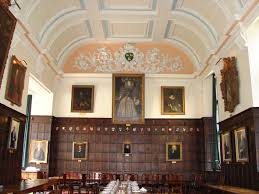Think of a theatre, and the image that will pop into your head will most likely be that of a proscenium arch. This standard theatre space has become ingrained in our imagination. Oxford has its standard theatre spaces, too: the Playhouse, the Pilch, the BT, the Keble O’Reilly. Using less conventional environments often creates unique dramatic effects and plays with that all-too impenetrable distance between actors and audience.
The college hall: the stage of many an overpriced meal, of lavish formal dinners, the backdrop to dreaded collections. Like the traditional theatre, the college hall has become so familiar to us that it has somewhat lost its power to shock and astound. Lucy Clarke’s rendition of John Webster’s The White Devil, which is being performed this Saturday, recreates the intimacy and claustrophobia of the Early Modern theatre through the vessel of Jesus College hall – Jesus being the only Oxford college to date from the Elizabethan period. For authenticity, the choice of stage could not be better.
I talked to Lucy, who wrote her Masters thesis on the similarities between the performance of law and drama in the 17th century, about directing in this piece of history. “This place is amazing. It looks like an indoor theatre which was built upon the principle of a Tudor theatre,” Lucy said. She believes that there could have been a production of The White Devil in this very hall in 1612/13, “I saw it and I just thought, I have to do this”.

When asked what the college hall offered that a more conventional space could not, Lucy told me, “Definitely intimacy. “This play is all about watching people; it’s about claustrophobia; it’s about seeing desire you shouldn’t see.” This translated extraordinarily well into the preview of the central trial scene I got to see. The cardinal’s (Noah Vickers) imperious taunting booms impressively in the echoing hall. Vittoria (Sophie Claypole) defends herself with the utmost sass, and the close proximity of the actors gives every smirk, grin, and wink, immeasurable potency. “You’re always on somebody’s toes in that theatre,” chuckled Lucy, half-jokingly. As grim figures marched, not across a raised stage, but right beside me, holding candles barely two feet away from my face, I understood what she meant. “Revenge tragedy is disquieting,” Lucy told me, “it’s meant to make you feel something you shouldn’t be able to feel […] This is like going to watch a horror film in so many ways and I think that’s what you’re going to get from seeing it like this.”
The actors have an audience on three sides of them, with two groups sitting on either side and another sat behind them on the balcony. This arrangement strengthens the link between theatre and legal court. They are “surrounded by an audience that can see you, and you can see them”. The atmosphere of anxiety is so palpable in an imposing building such as this. I will not spoil some of the other discomforting elements of the play but be warned that Lucy wants to create the “sense of being put at risk by theatre that is politically challenging, but also physically challenging”.
One aspect of the Early Modern theatre we might want to leave in the past is fire hazards. Not only are there candles strewn across the tables, but every character carries one. Luckily, this doesn’t cause movement to look stilted at all. “They’ve had a lit candle in their hands for three weeks. I’m not worried about them dropping it,” Lucy reassured me.
One might expect obtaining permission to perform in such a historical space to be impossible, but, as a Jesus student, the college gave Lucy the space for free. That said, she “had to send a lot of emails […] talk to the domestic bursar, the hall staff [….] it took probably a good six weeks of negotiations to get”. Fortunately, Lucy “believe[s] Jesus are quite keen to do it again”, and a free theatre space as authentic as this is not something to scoff at.
It is amazing how much excitement an original venue can bring to an already accomplished-looking production. As a final word, Lucy told me that she thinks “it’s so important to try using space in different ways […] I really hope this does continue. I think it’s such an opportunity that is just not used by so many students”.


